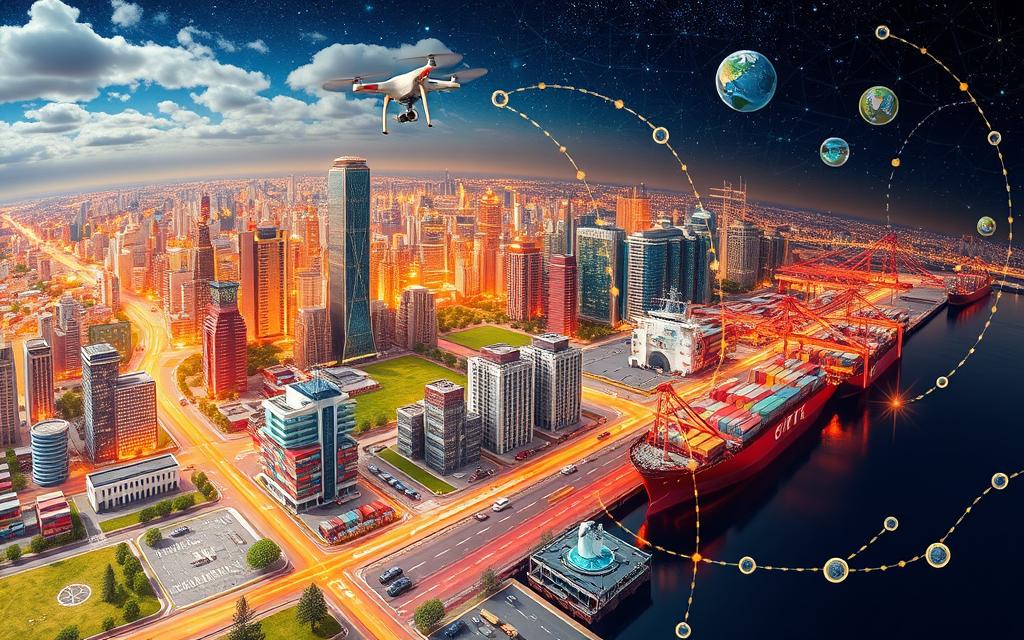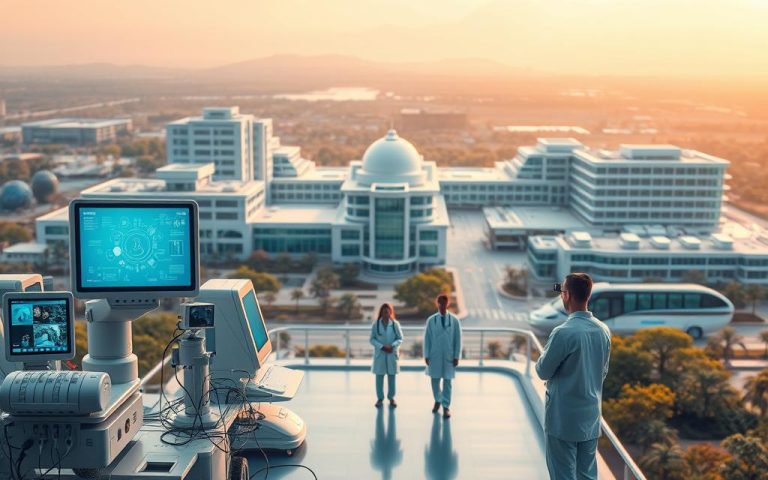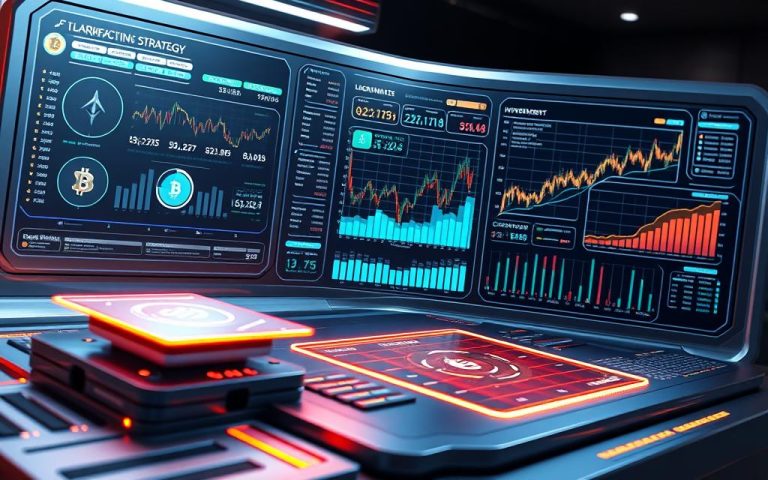Exploring Geographic Information Technology: Applications and Uses
Geographic Information Technology uses advanced tools for collecting, analysing, and understanding data related to places. This article will explore the many uses and importance of Geographic Information Systems (GIS) in different fields. Since GIS technology began in the 1960s, it has grown incredibly, thanks to pioneers like Roger Tomlinson.
GIS is now crucial for better spatial analysis and making informed choices. It helps organisations use geospatial data effectively. Many sectors, from city planning to environmental management, rely on GIS for their operations.
This discussion will highlight GIS’s key parts and varied uses, showing its big impact in several areas. We’ll see how important spatial data is. It helps us understand how things on Earth relate to each other.
Understanding Geographic Information Technology
Geographic Information Technology (GIT) involves various methods to collect, analyse, and show data about locations. It combines location data with details, helping organisations see patterns and relationships in spatial data. The GIS definition shows its importance in improving communication and decisions in different areas.
Core Concepts of Geographic Information Technology
Over the years, GIS has grown a lot. It has moved from just software on computers to using cloud and mobile apps. This change has made it easier to use spatial data. The Merrimack Valley Planning Commission (MVPC) uses GIS to help cities in northeastern Massachusetts. MVPC provides strong GIS services with experts in mapping.
GIT also makes things work better and helps in planning in many fields. For instance, the telecom and transport sectors use GIS to manage their systems and plan infrastructure. Emergency services find quicker routes, and businesses make better marketing choices using GIS. This shows how GIS functionality is useful in various settings.
| Industry | Application of GIS |
|---|---|
| Telecommunications | Designing communication networks |
| Transportation | Planning road networks and infrastructure |
| Emergency Services | Efficient routing for emergency vehicles |
| Businesses | Location selection and marketing strategies |
Education programs now focus on teaching GIS through practical work. Students do group projects and simulations to learn about geographic data. This hands-on learning is key to training future GIS experts.
What is Geographic Information Technology?
Geographic Information Technology (GIT) is about tools and methods that collect, handle, and examine data based on location. It links places with detailed data, giving deep insights into our world and nature. Using geospatial data analysis, GIT models data connections, aiding in smarter choices.
GIT has many uses, like in transport planning, figuring out health hazards, and responding to disasters. For example, it’s vital in studying watersheds to protect our water resources. The Federal Geographic Data Committee (FGDC) helps by setting standards for GIS tech, making it work well in different areas.
This field involves many people – from government agencies to local groups. They work together to get better at managing geography-based information. GIT also helps protect animals and their homes, showing its value in looking after our environment.
The demand for GIT is growing fast, expected to increase by 8.7% each year from 2024 to 2030. New tools like 3D maps and remote sensing make data gathering and showing easier. This brings more job opportunities in geospatial analysis and paves the way for new breakthroughs.
Key Components of Geographic Information Systems
Geographic Information Systems (GIS) depend on key parts working together. These parts give valuable insights and help in making decisions in various fields. Knowing about these GIS parts is vital for businesses that want to use this technology well.
GIS Software is at the heart of GIS. It provides the tools needed for storing, analysing, and showing geographic info. Users can work with spatial data, do analyses, and make detailed maps with this software. It meets the needs of many industries.
Hardware includes the powerful computers and servers needed to process big datasets efficiently. These advanced computers help businesses run smoother and be more productive.
Spatial Data is key to GIS. It is the location info that helps in making smart decisions. You can get this data yourself or buy it, making sure your GIS has a strong base.
People are essential in using GIS technology successfully. Experts, like planners and analysts, use GIS software. They turn spatial data into insights that can improve work and strategies in their areas.
Methods are the ways to gather, analyse, and understand spatial data. This includes remote sensing and geospatial analysis. These methods help to know more about how places relate to each other.
| Component | Description |
|---|---|
| GIS Software | Tools for storing, analysing, and displaying geographic information. |
| Hardware | High-performance computers and servers for efficient data processing. |
| Spatial Data | Location-based information critical for decision-making. |
| People | Professionals who manage and analyse GIS-based information. |
| Methods | Techniques for collecting and analysing spatial data. |
Diverse Industries Utilizing Geographic Information Technology
Geographic Information Technology is changing how different fields work. It boosts efficiency and helps in making smart decisions.
These fields have seen major benefits:
- Utilities: GIS is a big help here, used for grid management, pipeline tracking, and planning construction work.
- Infrastructure: Important for designing and keeping an eye on roads, water pipelines, and crucial buildings.
- Telecommunications: This industry uses GIS a lot for keeping up with network performance and customer habits.
- Retail: Shops use GIS to manage stock better, understand who their customers are and create winning marketing moves.
- Government: Geographic data is key in planning for emergencies, looking after infrastructure, and providing public services.
- Agriculture: Farmers use GIS to pick the best lands and handle water, making their work more productive.
- Healthcare: GIS helps in tracking diseases and outbreaks, making it vital for public health efforts.
- Insurance: Insurers analyze risks with GIS to set fair prices.
- Supply Chain Management: GIS makes supply chains more efficient, saving companies money.
- Forestry: It’s important for working out land use and ensuring timber is harvested responsibly.
- Urban Planning: Helps city planners use resources wisely and support green energy projects.
- Financial Services: Banks use GIS to choose branch locations by studying local people and how branches perform.
GIS isn’t just useful in these areas. Its impact is seen in everyday tasks and long-term plans. As geospatial tech gets better, there are even more chances for all sorts of fields to innovate with GIS.

| Industry | GIS Applications | Benefits |
|---|---|---|
| Utilities | Grid management, infrastructure monitoring | Improved efficiency, robust planning |
| Healthcare | Disease tracking and spatial analysis | Enhanced public health response |
| Agriculture | Crop planning, land management | Increased yields, resource optimisation |
| Telecommunications | Network monitoring, customer insights | Improved service delivery |
| Retail | Customer demographics, inventory optimisation | Effective marketing strategies |
Applications in Urban Planning and Development
GIS has changed how city development is planned. It combines various data types into one system. This allows for an in-depth understanding of factors affecting cities. It supports smarter decision-making.
Maps and graphics make it easier to share information. Everyone can access this data from anywhere, helping in planning together. This way, planners can work with communities to get their input.
GIS is great for understanding important details like health services, traffic, and how land is used. It helps planners make smart choices for the community and the environment. This keeps the balance between building new things and taking care of nature.
GIS gives reliable data for planning roads and other infrastructure. It helps make travel easier and cities better prepared for the future. It also helps care for parks and city facilities.
Even with its benefits, using GIS can be hard. It needs a lot of technical skills and money. But, places like Lagos and Abuja show how useful GIS can be for cities.
| Aspect | Description |
|---|---|
| Data Integration | Combines geographical, socioeconomic, and demographic data into a singular system. |
| Visual Communication | Utilises maps and graphics to enhance collaboration and stakeholder engagement. |
| Spatial Analysis | Evaluates diverse factors, including infrastructure and environmental constraints. |
| Resource Allocation | Informs decisions regarding land use and zoning based on comprehensive analyses. |
| Public Engagement | Enables resident feedback collection through location-based methods. |
| Resilience Planning | Aids in balancing urban development with environmental conservation. |
Transformative Role in Environmental Management
Geographic Information Systems (GIS) are key in managing our environment. They help combine and show different types of data related to the environment, making it easier to support sustainability. GIS lets experts study information about ecosystems, biodiversity, and natural resources. This means they can choose the best actions to help our planet.
GIS is great at finding the best spots for conservation or restoration projects. This helps keep biodiversity rich and saves natural resources well. For instance, GIS helps look after areas designated for conservation. It ensures these areas can keep thriving for years to come.
When it comes to fighting climate change, GIS is very valuable. It uses location intelligence to identify areas most at risk from climate change. This allows better preparedness against floods by mapping areas that might get flooded.
In the area of renewable energy, GIS helps by picking the best places for renewable energy projects. This makes sure we get the most power from them. It also tracks greenhouse gas emissions, helping to plan better climate actions.
GIS reduces environmental harm in different sectors. For infrastructure, it makes vehicle operations more efficient. This means less traffic jams and pollution. The telecom sector gets better network planning with GIS, reducing the need for extra inspections.
It also makes supply chains more sustainable by finding the shortest transport routes. This cuts down emissions. In waste management, GIS finds the best spots for recycling and waste processing.
In forestry, GIS helps watch for deforestation and manage resources better. This encourages sustainable practices and more tree planting. These uses of GIS show how important it is in managing our environment in many ways.
Adopting GIS technology, both private and public sectors can make better, more informed choices. This helps create a brighter, greener future for everyone.
Enhancing Agricultural Practices through Geographic Information Technology
GIS is revolutionising farming, making it more efficient and sustainable. Farmers use spatial data to make better decisions and boost productivity.
Precision farming via GIS technology examines crop health and optimises resource use. For example, Landsat 8 looks at nutrient levels and moisture with nine light bands. This helps farmers decide when to water and fertilise.
The soon-to-launch EOS SAT-1 satellite will Improve agricultural monitoring. It’s part of a plan to deploy seven satellites for farming observations. They’ll help farmers keep up with the weather and plant growth changes.
- Accurate field mapping and resource use with GPS.
- Sensors on farm equipment provide real-time crop data.
- Combining past plant data and 14-day weather forecasts helps planning.
- Better precision in fertiliser use thanks to detailed field info from GIS tools.
Deep learning with satellite data spots pests and diseases early for quick action. GIS also forecasts yields across different scenarios, enabling effective resource use.
GIS data quality improvements have made it more reliable and cheaper. Open-source GIS software’s growth means even small farmers can benefit. Various training resources help farmers learn to use GIS effectively.
FAO says geo-info could increase crop productivity by 20% worldwide. This shows GIS’s huge potential in agriculture, leading to smarter, more eco-friendly farming.
Conclusion
Geographic Information Technology, especially through Geographic Information Systems (GIS), is growing more essential. We are becoming a data-led world. Knowing about geographic data, like vector and raster differences, is key for experts wanting to use GIS fully. The future of GIS looks at better tools and letting users make choices based on solid spatial data analysis.
As more fields use geographic data in making choices, GIS’s value is clear. It helps businesses improve efficiency, plan better, and act fast in crises. For example, urban planners might use GIS to look at how many people live in an area. This helps them make plans for a greener future. Following rules like the U.S. National Spatial Data Infrastructure means firms can get the data they need.
Using Geographic Information Technology can change many areas for the better. Those skilled in GIS will help their sectors and promote a future where decisions are based on data. Knowing GIS’s limits and strengths adds to how it can improve how we work and live.
FAQ
What is Geographic Information Technology (GIT)?
Geographic Information Technology (GIT) involves using tools and methods to collect and interpret data related to locations. It combines location and attribute information to reveal patterns and connections.
How do Geographic Information Systems (GIS) function?
Geographic Information Systems (GIS) combine spatial data with descriptive data. This supports detailed mapping and analysis for different industries.
What are the core components of GIS?
GIS’s main parts include data analysis and visualisation software, data processing hardware, and the spatial data itself. It also requires skilled professionals and methods like remote sensing.
In which industries is GIS technology commonly used?
GIS technology is widely used in many fields. These include real estate for analyzing properties, agriculture for managing crops, and environmental management for conservation and disaster response.
How does GIS contribute to urban planning?
GIS helps urban planners find the best locations for development and analyze demographic patterns. It supports the creation of efficient and sustainable urban plans through spatial data mapping.
What role does GIS play in environmental management?
In environmental management, GIS is crucial for visualising and analysing ecological data. It supports conservation, tracks environmental changes, and helps plan disaster responses.
How is GIS used in agriculture?
GIS supports precision farming in agriculture. It helps farmers analyze soil, schedule irrigation, and monitor crop health. This leads to better crops and less environmental harm.
What are the future trends of Geographic Information Systems?
The future of GIS sees advancements in real-time data analysis and AI integration. It will be used more across sectors to enhance decision-making and efficiency.














